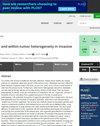基于外周压力波形的无创卒中量和心血管参数评估。
IF 3.6
2区 生物学
引用次数: 0
摘要
心血管疾病是导致全球死亡的主要原因,因此开发能深入了解心血管系统状态的无创且简单易用的工具至关重要。我们研究了使用外周脉搏波记录来估算每搏量(SV)和描述心血管系统选定特性的特定受试者参数的可能性。我们使用眼压计(SphygmoCor)记录了 35 名血液透析(HD)患者和 14 名健康受试者桡动脉的外周压力波形。然后利用压力波形估算脉搏波传播数学模型和基于弹性的左心室模型的特定受试者参数。生物阻抗心动图测量(PhysioFlow)对模型估计的 SV 进行了验证。对于 HD 组和对照组,模拟压力波形和测量压力波形之间的平均绝对百分比误差分别为 4.0% 和 2.8%。模型估计的 SV 与基于生物阻抗的 SV 之间存在中度相关性(对照组和 HD 患者的相关性分别为 r = 0.57,p<0.05;r = 0.58,p<0.001)。我们还观察到,HD 患者(r = 0.84,p<0.001)和对照组(r = 0.70,p<0.01)的左心室收缩末期弹性估计值与外周收缩压之间存在相关性。这些初步结果表明,经过进一步验证和可能的进一步改进以提高准确性后,所建议的方法可支持对卒中量和选定的心脏功能参数及血管特性进行无创评估。重要的是,建议的方法有可能在现有的外周压力波形测量设备中实施。本文章由计算机程序翻译,如有差异,请以英文原文为准。
Non-invasive assessment of stroke volume and cardiovascular parameters based on peripheral pressure waveform.
Cardiovascular diseases are the leading cause of death globally, making the development of non-invasive and simple-to-use tools that bring insights into the state of the cardiovascular system of utmost importance. We investigated the possibility of using peripheral pulse wave recordings to estimate stroke volume (SV) and subject-specific parameters describing the selected properties of the cardiovascular system. Peripheral pressure waveforms were recorded in the radial artery using applanation tonometry (SphygmoCor) in 35 hemodialysis (HD) patients and 14 healthy subjects. The pressure waveforms were then used to estimate subject-specific parameters of a mathematical model of pulse wave propagation coupled with the elastance-based model of the left ventricle. Bioimpedance cardiography measurements (PhysioFlow) were performed to validate the model-estimated SV. Mean absolute percentage error between the simulated and measured pressure waveforms was 4.0% and 2.8% for the HD and control group, respectively. We obtained a moderate correlation between the model-estimated and bioimpedance-based SV (r = 0.57, p<0.05, and r = 0.58, p<0.001, for the control group and HD patients, respectively). We also observed a correlation between the estimated end-systolic elastance of the left ventricle and the peripheral systolic pressure in both HD patients (r = 0.84, p<0.001) and the control group (r = 0.70, p<0.01). These preliminary results suggest that, after additional validation and possibly further refinement to increase accuracy, the proposed methodology could support non-invasive assessment of stroke volume and selected heart function parameters and vascular properties. Importantly, the proposed method could be potentially implemented in the existing devices measuring peripheral pressure waveforms.
求助全文
通过发布文献求助,成功后即可免费获取论文全文。
去求助
来源期刊

PLoS Computational Biology
生物-生化研究方法
CiteScore
7.10
自引率
4.70%
发文量
820
期刊介绍:
PLOS Computational Biology features works of exceptional significance that further our understanding of living systems at all scales—from molecules and cells, to patient populations and ecosystems—through the application of computational methods. Readers include life and computational scientists, who can take the important findings presented here to the next level of discovery.
Research articles must be declared as belonging to a relevant section. More information about the sections can be found in the submission guidelines.
Research articles should model aspects of biological systems, demonstrate both methodological and scientific novelty, and provide profound new biological insights.
Generally, reliability and significance of biological discovery through computation should be validated and enriched by experimental studies. Inclusion of experimental validation is not required for publication, but should be referenced where possible. Inclusion of experimental validation of a modest biological discovery through computation does not render a manuscript suitable for PLOS Computational Biology.
Research articles specifically designated as Methods papers should describe outstanding methods of exceptional importance that have been shown, or have the promise to provide new biological insights. The method must already be widely adopted, or have the promise of wide adoption by a broad community of users. Enhancements to existing published methods will only be considered if those enhancements bring exceptional new capabilities.
 求助内容:
求助内容: 应助结果提醒方式:
应助结果提醒方式:


